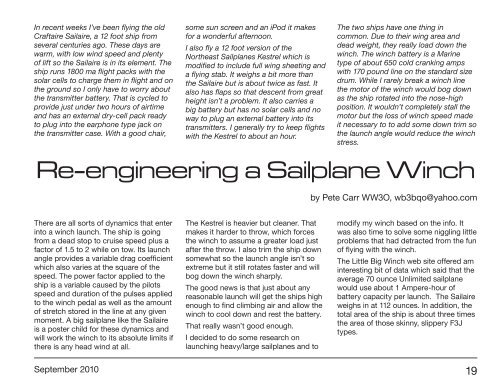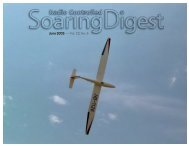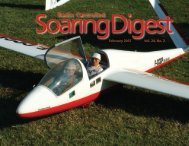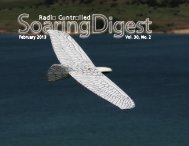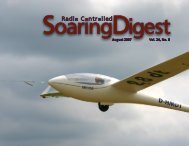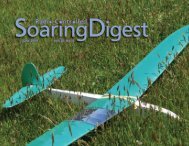Sep - RCSoaring.com
Sep - RCSoaring.com
Sep - RCSoaring.com
You also want an ePaper? Increase the reach of your titles
YUMPU automatically turns print PDFs into web optimized ePapers that Google loves.
In recent weeks I’ve been flying the old<br />
Craftaire Sailaire, a 12 foot ship from<br />
several centuries ago. These days are<br />
warm, with low wind speed and plenty<br />
of lift so the Sailaire is in its element. The<br />
ship runs 1800 ma flight packs with the<br />
solar cells to charge them in flight and on<br />
the ground so I only have to worry about<br />
the transmitter battery. That is cycled to<br />
provide just under two hours of airtime<br />
and has an external dry-cell pack ready<br />
to plug into the earphone type jack on<br />
the transmitter case. With a good chair,<br />
some sun screen and an iPod it makes<br />
for a wonderful afternoon.<br />
I also fly a 12 foot version of the<br />
Northeast Sailplanes Kestrel which is<br />
modified to include full wing sheeting and<br />
a flying stab. It weighs a bit more than<br />
the Sailaire but is about twice as fast. It<br />
also has flaps so that descent from great<br />
height isn’t a problem. It also carries a<br />
big battery but has no solar cells and no<br />
way to plug an external battery into its<br />
transmitters. I generally try to keep flights<br />
with the Kestrel to about an hour.<br />
The two ships have one thing in<br />
<strong>com</strong>mon. Due to their wing area and<br />
dead weight, they really load down the<br />
winch. The winch battery is a Marine<br />
type of about 650 cold cranking amps<br />
with 170 pound line on the standard size<br />
drum. While I rarely break a winch line<br />
the motor of the winch would bog down<br />
as the ship rotated into the nose-high<br />
position. It wouldn’t <strong>com</strong>pletely stall the<br />
motor but the loss of winch speed made<br />
it necessary to to add some down trim so<br />
the launch angle would reduce the winch<br />
stress.<br />
Re-engineering a Sailplane Winch<br />
by Pete Carr WW3O, wb3bqo@yahoo.<strong>com</strong><br />
There are all sorts of dynamics that enter<br />
into a winch launch. The ship is going<br />
from a dead stop to cruise speed plus a<br />
factor of 1.5 to 2 while on tow. Its launch<br />
angle provides a variable drag coefficient<br />
which also varies at the square of the<br />
speed. The power factor applied to the<br />
ship is a variable caused by the pilots<br />
speed and duration of the pulses applied<br />
to the winch pedal as well as the amount<br />
of stretch stored in the line at any given<br />
moment. A big sailplane like the Sailaire<br />
is a poster child for these dynamics and<br />
will work the winch to its absolute limits if<br />
there is any head wind at all.<br />
The Kestrel is heavier but cleaner. That<br />
makes it harder to throw, which forces<br />
the winch to assume a greater load just<br />
after the throw. I also trim the ship down<br />
somewhat so the launch angle isn’t so<br />
extreme but it still rotates faster and will<br />
bog down the winch sharply.<br />
The good news is that just about any<br />
reasonable launch will get the ships high<br />
enough to find climbing air and allow the<br />
winch to cool down and rest the battery.<br />
That really wasn’t good enough.<br />
I decided to do some research on<br />
launching heavy/large sailplanes and to<br />
modify my winch based on the info. It<br />
was also time to solve some niggling little<br />
problems that had detracted from the fun<br />
of flying with the winch.<br />
The Little Big Winch web site offered am<br />
interesting bit of data which said that the<br />
average 70 ounce Unlimited sailplane<br />
would use about 1 Ampere-hour of<br />
battery capacity per launch. The Sailaire<br />
weighs in at 112 ounces. In addition, the<br />
total area of the ship is about three times<br />
the area of those skinny, slippery F3J<br />
types.<br />
<strong>Sep</strong>tember 2010 19


